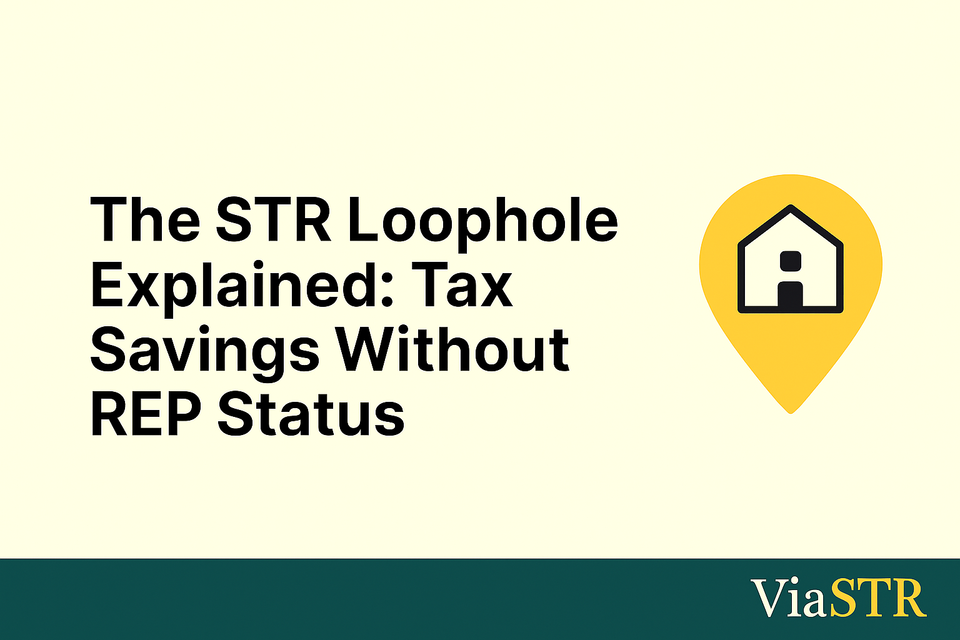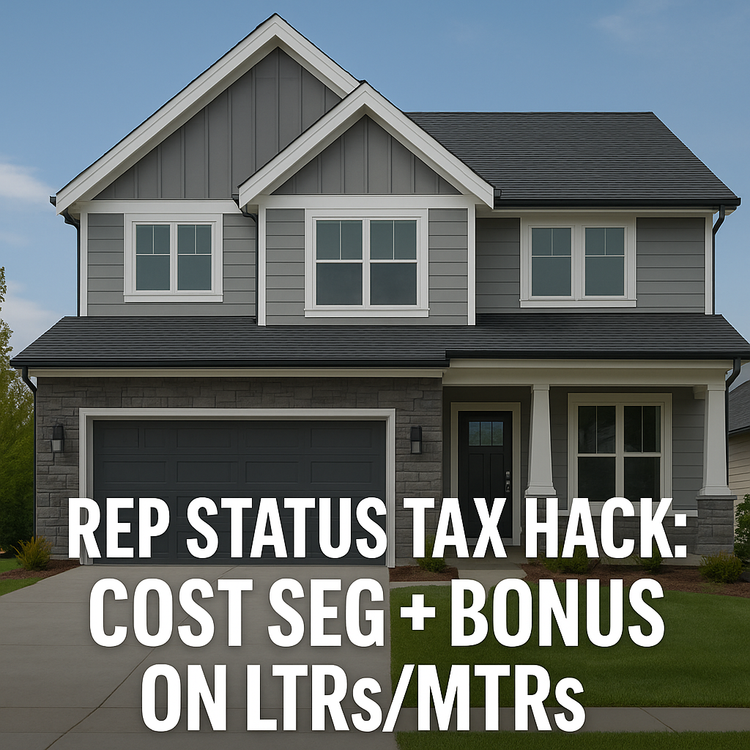The STR Loophole Explained: Tax Savings Without REP Status

If you're a high-income W2 earner, you know the sting of watching 30–40% of your paycheck vanish to taxes.
What if you could legally keep more of what you earn — without quitting your job or becoming a full-time real estate professional?
That’s where the Short-Term Rental (STR) loophole comes in — one of the most powerful (and overlooked) tax strategies in the U.S. tax code.
At a Glance
- STRs let W2 earners access tax benefits without Real Estate Professional (REP) status.
- Material participation is the key — not the number of hours worked in real estate.
- With cost segregation and 100% bonus depreciation, you can deduct $50K–$150K+ in year one.
- Tax savings often exceed the down payment required to buy your first STR.
- You can offset W2 income without quitting your job — a huge advantage over long-term rentals.
What Is the STR Loophole?
The STR loophole is a legal exception in the tax code that allows short-term rentals to be treated as active income rather than passive — even if you’re not a full-time real estate professional.
“Most W2 earners think they need REP status to unlock big real estate deductions. STRs break that rule — and break open a whole new path to wealth.”
The Technical Rule
If:
- The average guest stay is 7 days or less, and
- You materially participate in the property (meeting one of the IRS participation tests),
Then:
- You can take active losses from depreciation, even against W2 or 1099 income.
This is a huge deal. Normally, passive real estate losses can only offset passive income — but STRs are treated differently under IRS regulations (Reg. § 1.469-1T(e)(3)(ii)(A)).
The Core Tax Advantages
🧾 Cost Segregation Studies
Break down your property into components (roof, appliances, lighting, HVAC, etc.) and accelerate depreciation on parts that wear out faster.
💥 100% Bonus Depreciation
Thanks to the Opportunity to Build and Boost Bill (OBBB), 100% bonus depreciation is back. This lets you deduct the full value of eligible property elements in year one.
💰 Offset W2 Income
If you meet material participation rules, your depreciation losses can offset high W2 earnings, even in the 37% bracket.
🔢 Real Example
You buy a $600,000 STR.
A cost segregation study reveals $200,000 in 5-, 7-, and 15-year components.
You take 100% bonus depreciation in year one.
| Action | Impact |
|---|---|
| Bonus Depreciation | $200,000 write-off |
| Tax Rate | 37% |
| Estimated Tax Savings | $74,000 |
That’s more than your $60K down payment — making STRs one of the only assets that can pay you back on day one.
Why This Is a Game-Changer for W2 Earners
Most tax strategies in real estate require you to:
- Quit your job
- Get a real estate license
- Track 750+ hours in real estate activities
But with STRs, you can:
- ✅ Keep your W2 job
- ✅ Claim large deductions
- ✅ Use depreciation to lower your taxable income
- ✅ Buy multiple properties with recycled tax savings
"STRs are the loophole that unlocks true wealth-building for high earners — without giving up your career."
Meeting the Material Participation Test
You must meet one of these IRS tests to qualify:
- You work 500+ hours on the property per year.
- You do substantially all of the work (e.g., self-managing).
- You work 100+ hours, and no one else does more than you.
Examples of eligible activities include:
- Messaging guests
- Managing cleaners
- Pricing and listing updates
- Maintenance coordination
- Booking setup and automation
💡 Tip: Use tools like REPSLog or a time-tracking spreadsheet to prove your hours.
Risk & Reward: The IRS Lens
The STR loophole is powerful, but the IRS scrutinizes material participation claims.
To stay compliant:
- Track all hours with a dated log (REPSLog or spreadsheet)
- Avoid full-service property managers if aiming for tax deductions
- Consult a CPA familiar with STR rules
Case Study: Kevin, the High-Income Sales Leader
Kevin earns $500K/year in tech sales.
He bought a $700K STR, used cost segregation, and booked $230K in year-one bonus depreciation.
✅ He worked 120+ hours managing it himself.
✅ He used the savings to buy a second STR in year two.
✅ He dropped his effective tax rate by 15%, saving $85,100 in federal taxes.
Today, Kevin’s STR portfolio covers his mortgage and funds family travel — all while keeping his W2 role.
What’s Next?
Understanding the STR loophole is step one. Step two? Pick the right market to invest in — one with strong occupancy, limited regulations, and high ROI potential.
👉 Next Post: How to Choose the Right Market for Your STR
(Coming soon — sign up to get notified.)
See Also
- Advanced Tax Strategies for STR Investors
- Building Your STR Vision: From Financial Goals to Generational Wealth
- Setting Up Your STR Business: LLCs, Insurance, and Compliance



